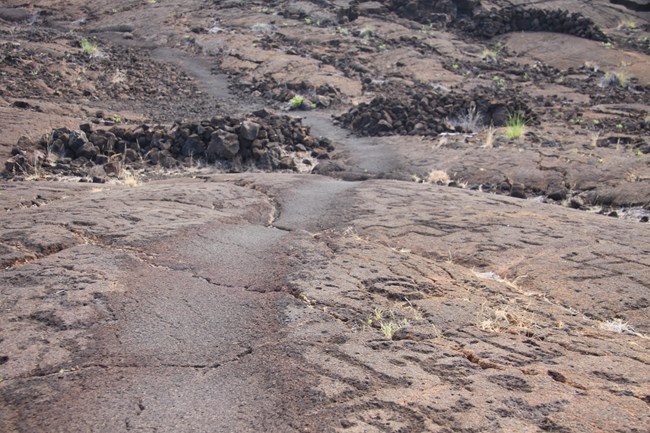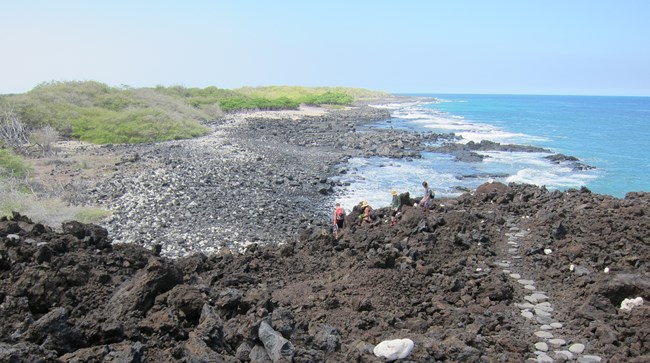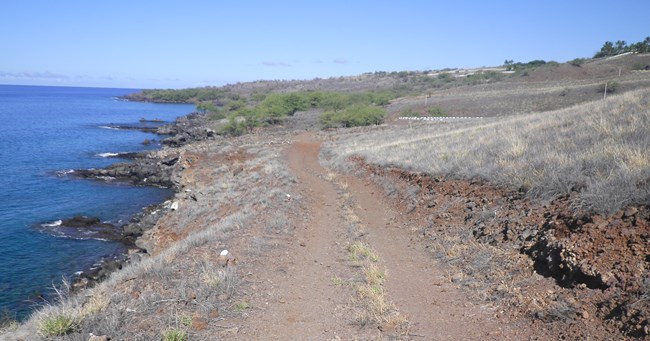|
Hawaiʻi’s prehistoric ala loa (long trails) generally follow the path of least resistance along natural contours of the land. The ala loa connected a network of shorter coastal trails, sometimes referred to as ala hele (general trail term), and intersected mauka-makai (mountain to ocean) trails. Although these names are presented here as definitional, native and historic terminology is highly unique in different locations. Most ahupua‘a (land divisions) have one or more mauka-makai trails. Trails often followed streams or cliff edges, and some became the delineating boundaries between neighboring ahupuaʻa. 
NPS / P. Gorman Trails allowed travel across incredibly harsh terrian, such as this ʻaʻā lava flow. The surface of this particular trail is filled with small, smooth stones to make travel more comfortable, and features curb lined edges. 
NPS The smooth, rolling nature of pāhoehoe lava flows makes walking across it relatively easy. Often, due to topography, travelers were naturally guided into using the same path across a flow. The result over hundreds of years of repetitive foot travel is a distinct indentation and sheen due to the wearing down of the surface of the pahoehoe lava flow. In this photo, the trail is easily identified by its dark groove across the pāhoehoe lava flow, and on both sides of the trail is dense array of petroglyphs, or kiʻi pōhaku. These hand-pecked treasures are incredibly delicate, and provide modern generations an invaluable window into the world of ka poʻe kahiko, the people of old. 
NPS Bays, inlets, beaches, and other types of shorelines which provide protection from open ocean swells and currents and/or make ocean access easier were very valuable natural resources. It was common for trails to connect to and across these features. At the northern end of Pu'ukoholā Heiau National Historical Park the Ala Kahakai crosses the sandy shoreline of Pelekane Bay. 
NPS / R. Gmirkin An interesting trail adaptation is the addition of smooth waterworn stones (ʻalā or paʻalā) along the center of a trail over rough terrain (such as ʻaʻā lava). The stones made foot travel over long distances faster and more comfortable. Horses, donkeys, and cattle arrived in Hawaiʻi in the late 1700s. These animals were guided across the land on existing trails. The smooth stepping stones found on some trails caused them to slip, so they were often moved aside or removed. In this picture, the stepping stones disappear as soon as the ʻaʻā lava flow ends, and a wandering coastal trail resumes. 
NPS In the 20th century, many trails became modernized as technology and societal needs changed. People began using motorized vehicles on older pathways, while modifying them to accommodate their needs. Sometimes, these modifications were made directly over the alignments of ancient trails. In other instances, they created completely new roads. Additionally, some trails were relocated due to natural events such as lava flows or tsunamis. These Hawaiian trails and their configuration have been a dynamic and ever-changing component of island life for centuries! |
Last updated: April 30, 2025
